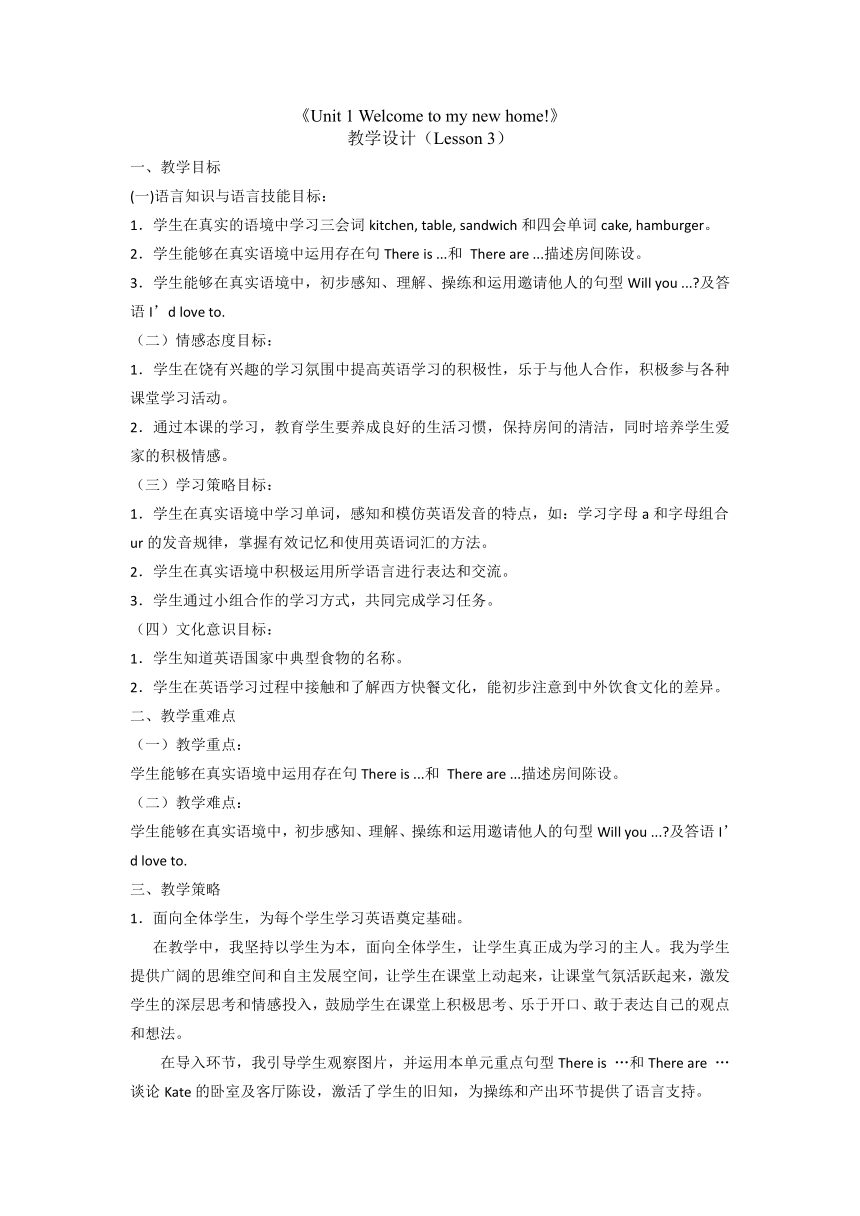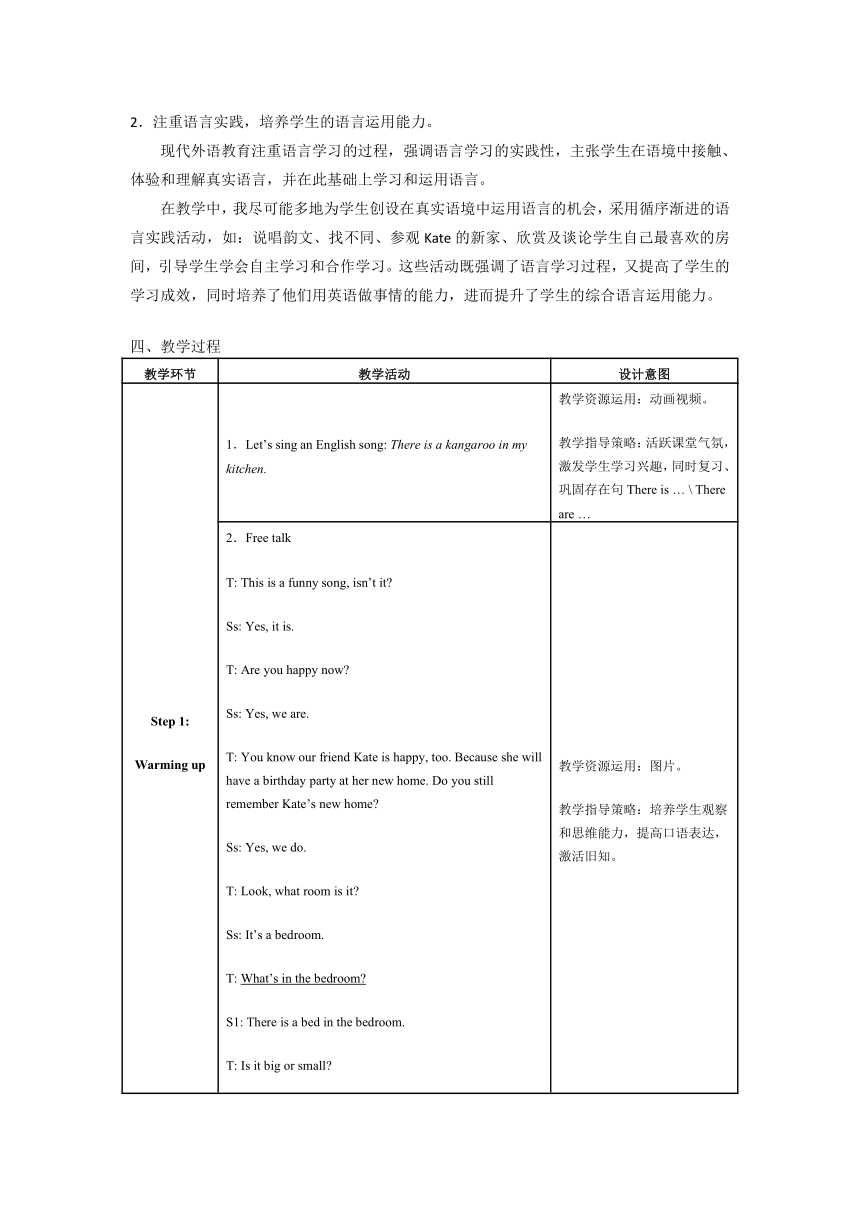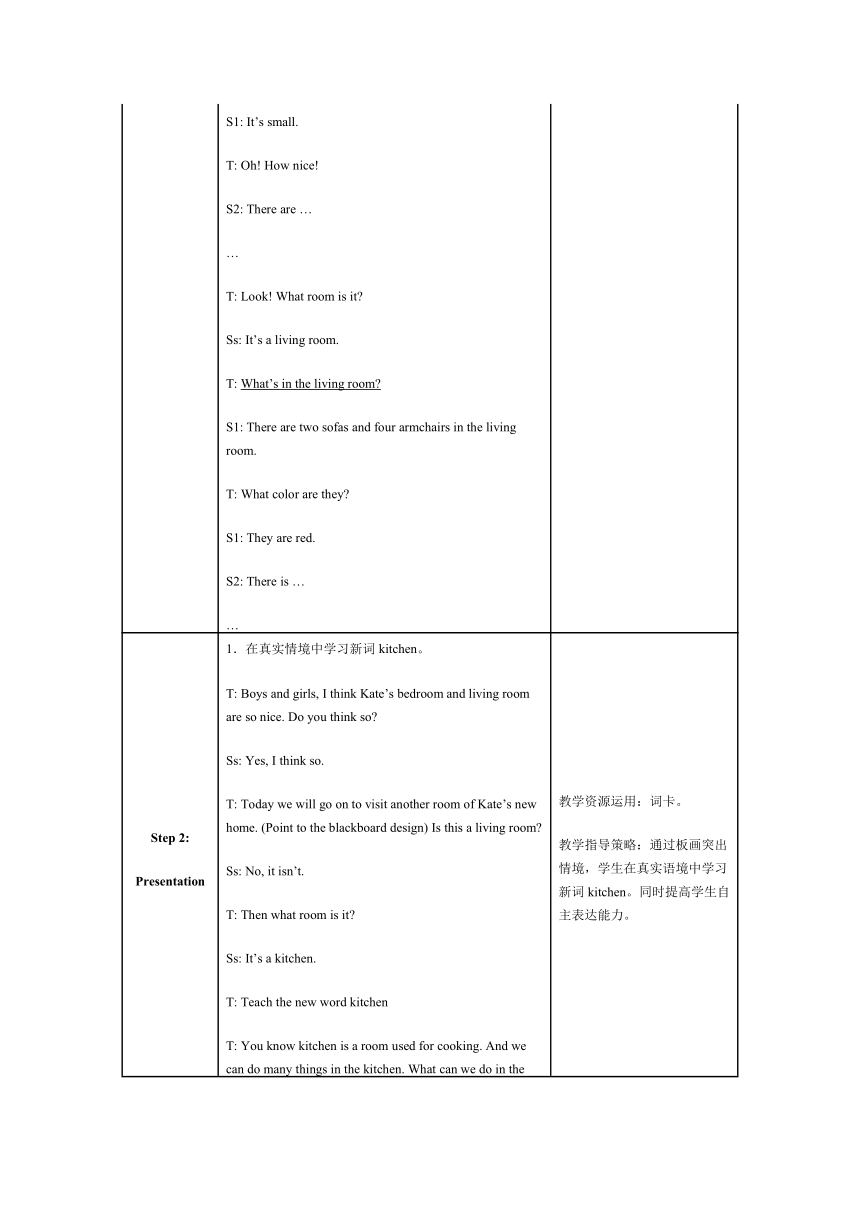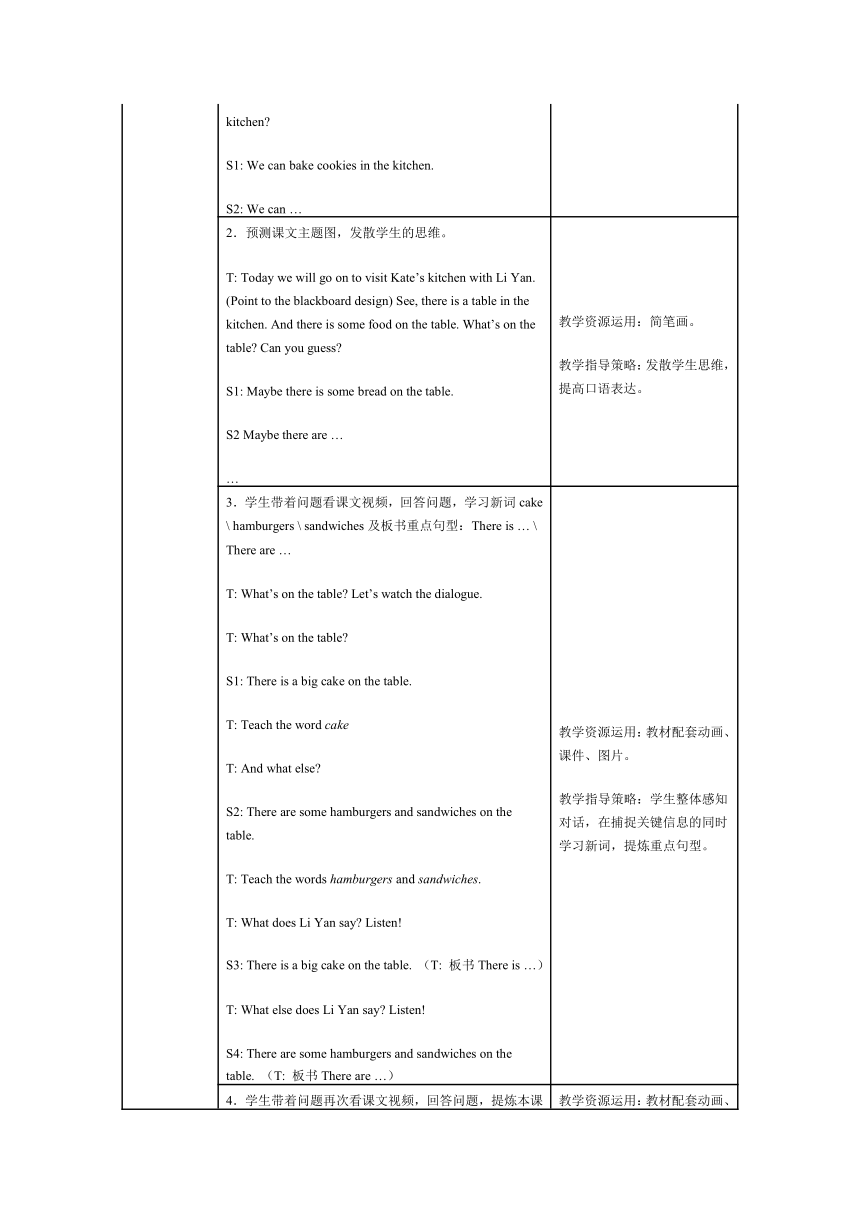Unit 1 Welcome to my new home!(Lesson 3)表格式教案
文档属性
| 名称 | Unit 1 Welcome to my new home!(Lesson 3)表格式教案 |  | |
| 格式 | doc | ||
| 文件大小 | 49.5KB | ||
| 资源类型 | 教案 | ||
| 版本资源 | 人教精通版(三年级起点) | ||
| 科目 | 英语 | ||
| 更新时间 | 2021-06-13 17:30:51 | ||
图片预览




文档简介
《Unit 1 Welcome to my new home!》
教学设计(Lesson 3)
一、教学目标
(一)语言知识与语言技能目标:
1.学生在真实的语境中学习三会词kitchen, table, sandwich和四会单词cake, hamburger。
2.学生能够在真实语境中运用存在句There is ...和 There are ...描述房间陈设。
3.学生能够在真实语境中,初步感知、理解、操练和运用邀请他人的句型Will you ...?及答语I’d love to.
(二)情感态度目标:
1.学生在饶有兴趣的学习氛围中提高英语学习的积极性,乐于与他人合作,积极参与各种课堂学习活动。
2.通过本课的学习,教育学生要养成良好的生活习惯,保持房间的清洁,同时培养学生爱家的积极情感。
(三)学习策略目标:
1.学生在真实语境中学习单词,感知和模仿英语发音的特点,如:学习字母a和字母组合ur的发音规律,掌握有效记忆和使用英语词汇的方法。
2.学生在真实语境中积极运用所学语言进行表达和交流。
3.学生通过小组合作的学习方式,共同完成学习任务。
(四)文化意识目标:
1.学生知道英语国家中典型食物的名称。
2.学生在英语学习过程中接触和了解西方快餐文化,能初步注意到中外饮食文化的差异。
二、教学重难点
(一)教学重点:
学生能够在真实语境中运用存在句There is ...和 There are ...描述房间陈设。
(二)教学难点:
学生能够在真实语境中,初步感知、理解、操练和运用邀请他人的句型Will you ...?及答语I’d love to.
三、教学策略
1.面向全体学生,为每个学生学习英语奠定基础。
在教学中,我坚持以学生为本,面向全体学生,让学生真正成为学习的主人。我为学生提供广阔的思维空间和自主发展空间,让学生在课堂上动起来,让课堂气氛活跃起来,激发学生的深层思考和情感投入,鼓励学生在课堂上积极思考、乐于开口、敢于表达自己的观点和想法。
在导入环节,我引导学生观察图片,并运用本单元重点句型There is …和There are …谈论Kate的卧室及客厅陈设,激活了学生的旧知,为操练和产出环节提供了语言支持。
2.注重语言实践,培养学生的语言运用能力。
现代外语教育注重语言学习的过程,强调语言学习的实践性,主张学生在语境中接触、体验和理解真实语言,并在此基础上学习和运用语言。
在教学中,我尽可能多地为学生创设在真实语境中运用语言的机会,采用循序渐进的语言实践活动,如:说唱韵文、找不同、参观Kate的新家、欣赏及谈论学生自己最喜欢的房间,引导学生学会自主学习和合作学习。这些活动既强调了语言学习过程,又提高了学生的学习成效,同时培养了他们用英语做事情的能力,进而提升了学生的综合语言运用能力。
四、教学过程
教学环节 教学活动 设计意图
Step 1: Warming up 1.Let’s sing an English song: There is a kangaroo in my kitchen. 教学资源运用:动画视频。
教学指导策略:活跃课堂气氛,激发学生学习兴趣,同时复习、巩固存在句There is … \ There are …
2.Free talk
T: This is a funny song, isn’t it?
Ss: Yes, it is.
T: Are you happy now?
Ss: Yes, we are.
T: You know our friend Kate is happy, too. Because she will have a birthday party at her new home. Do you still remember Kate’s new home?
Ss: Yes, we do.
T: Look, what room is it?
Ss: It’s a bedroom.
T: What’s in the bedroom?
S1: There is a bed in the bedroom.
T: Is it big or small?
S1: It’s small.
T: Oh! How nice!
S2: There are …
…
T: Look! What room is it?
Ss: It’s a living room.
T: What’s in the living room?
S1: There are two sofas and four armchairs in the living room.
T: What color are they?
S1: They are red.
S2: There is …
… 教学资源运用:图片。
教学指导策略:培养学生观察和思维能力,提高口语表达,激活旧知。
Step 2: Presentation 1.在真实情境中学习新词kitchen。
T: Boys and girls, I think Kate’s bedroom and living room are so nice. Do you think so?
Ss: Yes, I think so.
T: Today we will go on to visit another room of Kate’s new home. (Point to the blackboard design) Is this a living room?
Ss: No, it isn’t.
T: Then what room is it?
Ss: It’s a kitchen.
T: Teach the new word kitchen
T: You know kitchen is a room used for cooking. And we can do many things in the kitchen. What can we do in the kitchen?
S1: We can bake cookies in the kitchen.
S2: We can … 教学资源运用:词卡。
教学指导策略:通过板画突出情境,学生在真实语境中学习新词kitchen。同时提高学生自主表达能力。
2.预测课文主题图,发散学生的思维。
T: Today we will go on to visit Kate’s kitchen with Li Yan. (Point to the blackboard design) See, there is a table in the kitchen. And there is some food on the table. What’s on the table? Can you guess?
S1: Maybe there is some bread on the table.
S2 Maybe there are …
… 教学资源运用:简笔画。
教学指导策略:发散学生思维,提高口语表达。
3.学生带着问题看课文视频,回答问题,学习新词cake \ hamburgers \ sandwiches及板书重点句型:There is … \ There are …
T: What’s on the table? Let’s watch the dialogue.
T: What’s on the table?
S1: There is a big cake on the table.
T: Teach the word cake
T: And what else?
S2: There are some hamburgers and sandwiches on the table.
T: Teach the words hamburgers and sandwiches.
T: What does Li Yan say? Listen!
S3: There is a big cake on the table. (T: 板书There is …)
T: What else does Li Yan say? Listen!
S4: There are some hamburgers and sandwiches on the table. (T: 板书There are …) 教学资源运用:教材配套动画、课件、图片。
教学指导策略:学生整体感知对话,在捕捉关键信息的同时学习新词,提炼重点句型。
4.学生带着问题再次看课文视频,回答问题,提炼本课难点句型Will you …?和I’d love to.
T: We know Kate will invite Li Yan to her birthday party. What does Kate ask? Let’s watch the dialogue again.
T: What does Kate ask?
S1: Will you come to my birthday party?
T: Will Li Yan come to Kate’s birthday party?
Ss: Sure!
T: How do you know?
S2: I’d love to. 教学资源运用:教材配套动画、课件。
教学指导策略:学生再次整体感知对话,在捕捉关键信息的同时提炼难点句型。
5.角色体验
T: Now let’s have a role play.
(Kate: Will you come to my birthday party? \ Li Yan: I’d love to.) 教学资源运用:人物头饰、PPT演示文稿。
教学指导策略:在真实语境中操练本课难点句型Will you …?和I’d love to.
Step 3: Practice 1.多种形式朗读对话,内化语言。
(1) Listen and repeat the dialogue.
(2) Teacher and one student read the dialogue in different roles.
(3) Open the books and read in different roles.
(4) Show the role-play reading.
(5) Teacher and one student act the dialogue.
(6) Close the books and act in pairs.
(7) Show the acts. 教学资源运用:PPT演示文稿、教材、人物头饰。
教学指导策略:通过不同形式的朗读对话,内化语言。从个人到小组到全班的活动,从模仿读,到自己认读,到分角色朗读课文。依据学生的需求,由浅入深,逐层递进,帮助学困生掌握本课最基本的知识,落实本课的重点知识,培养学生听说认读的习惯和合作精神。
2.韵文说唱。
T: We know Kate will have a birthday party at her new home. And I prepare a chant for her party. Will you chant now?
Ss: Sure! I’d love to. 教学资源运用:教师创编韵律诗,教师自制PPT演示文稿。
教学指导策略:学生进行演唱韵律诗,复习巩固重点句型。
3.游戏:找不同。
T: Today Li Yan is very happy at Kate’s new home. And now they want to play a game. Will you join them?
Ss: Sure! I’d love to.
T: Look at this picture. There are two kitchens in it. This is kitchen A and this is kitchen B. And there are many differences between them. See, there is a table in kitchen A. What can you see in kitchen B?
S1: There is a table in kitchen B.
T: Are they different?
S1: Yes. The table in kitchen A is brown. But the table in kitchen B is yellow.
T: Right! Now please talk about the differences between kitchen A and kitchen B. Wok in pairs.
T: How many chairs? \ What’s on the wall? \ What’s on the table? \ What’s on the desk?
Pair work: Sa: In kitchen A, there is \ are …
Sb: In kitchen B, there is \ are …
T: Look! There are many differences between kitchen A and kitchen B. Which kitchen do you like? Why?
S: I like kitchen B. Because it’s very clean.
T: I agree with you. I think kitchen B is very nice and clean. But kitchen A is very dirty and messy. See, there is some peel on the floor and the chairs are crooked. So we should keep our rooms clean. Do you think so?
Ss: Yes, I think so. 教学资源运用:PPT演示文稿。
教学指导策略:培养学生观察、思维和表达能力,学生小组合作操练所学语言,培养合作精神,同时渗透积极的情感态度:养成良好的生活习惯,保持房间的清洁。
4.参观Kate的新家。
T: We know Kate will have a birthday party at her new home. Will you come to her new home?
Ss: Sure! I’d love to.
T: Now let’s go and visit Kate’s new home. The first room we will visit is Kate’s kitchen. Oh! How nice! Group 1, you will be here and talk about Kate’s kitchen. Clear?
Group 1: Yes.
T:Then we go ahead. The next room we will visit is Kate’s living room. Oh! How big! Group 2, you will visit Kate’s living room. OK?
Group 2: OK!
T: And then, we go upstairs. The third room we will visit is Kate’s study. It looks small but nice. Group 3, you will sit here and talk about Kate’s study. Understand?
Group 3: Yes.
T: And the last room we will visit is Kate’s bedroom. It looks very comfortable. Group 4, you will visit Kate’s bedroom. OK?
Group 4: OK!
T: Wait a minute! Before visiting Kate’s new home, I’ll give you an example. Now I’m Kate, Who will be the visitor? (师生示范)
T: Now let’s go and visit Kate’s new home. Please work in pairs. One is Kate, the other is the visitor.
Ss: Visit Kate’s new home in pairs.
Show the acts. 教学资源运用:PPT演示文稿。
教学指导策略:学生在真实语境中运用所学语言,培养学生综合语言运用能力,同时培养了学生小组合作精神。
Step 4: Production 1.学生观看视频,欣赏自己最喜爱的房间。
T: I like Kate’s new home very much. But I like my own home best. Do you love your own homes?
Ss: Yes, I do.
T: As we know, east, west, home is best! So we should love our own homes, right?
Ss: Yes.
T: Now let’s enjoy our favorite rooms. 教学资源运用:自制短片。
教学指导策略:充分开发和利用学生资源,有效激活学生已有的知识和经验,激发学生的学习兴趣,丰富教学内容。
2.小组合作谈论自己最喜爱的房间。
T: Boys and girls, show me your photos. Let’s talk about our favorite rooms. First I’ll set an example for you.(师生示范)
T: Please talk about your favorite rooms with your partners.
Ss: Talk about their favorite rooms in pairs.
Show the acts. 教学资源运用:房间照片。
教学指导策略:充分开发和利用学生资源,有效激活学生已有的知识和经验,激发学生的学习兴趣,丰富教学内容。同时,学生在真实语境中运用所学语言,发展了综合语言运用能力,培养了小组合作精神。
Step 5: Ending Homework:
1.Recite the dialogue.
2.Introduce your favorite room to your partner.
教学设计(Lesson 3)
一、教学目标
(一)语言知识与语言技能目标:
1.学生在真实的语境中学习三会词kitchen, table, sandwich和四会单词cake, hamburger。
2.学生能够在真实语境中运用存在句There is ...和 There are ...描述房间陈设。
3.学生能够在真实语境中,初步感知、理解、操练和运用邀请他人的句型Will you ...?及答语I’d love to.
(二)情感态度目标:
1.学生在饶有兴趣的学习氛围中提高英语学习的积极性,乐于与他人合作,积极参与各种课堂学习活动。
2.通过本课的学习,教育学生要养成良好的生活习惯,保持房间的清洁,同时培养学生爱家的积极情感。
(三)学习策略目标:
1.学生在真实语境中学习单词,感知和模仿英语发音的特点,如:学习字母a和字母组合ur的发音规律,掌握有效记忆和使用英语词汇的方法。
2.学生在真实语境中积极运用所学语言进行表达和交流。
3.学生通过小组合作的学习方式,共同完成学习任务。
(四)文化意识目标:
1.学生知道英语国家中典型食物的名称。
2.学生在英语学习过程中接触和了解西方快餐文化,能初步注意到中外饮食文化的差异。
二、教学重难点
(一)教学重点:
学生能够在真实语境中运用存在句There is ...和 There are ...描述房间陈设。
(二)教学难点:
学生能够在真实语境中,初步感知、理解、操练和运用邀请他人的句型Will you ...?及答语I’d love to.
三、教学策略
1.面向全体学生,为每个学生学习英语奠定基础。
在教学中,我坚持以学生为本,面向全体学生,让学生真正成为学习的主人。我为学生提供广阔的思维空间和自主发展空间,让学生在课堂上动起来,让课堂气氛活跃起来,激发学生的深层思考和情感投入,鼓励学生在课堂上积极思考、乐于开口、敢于表达自己的观点和想法。
在导入环节,我引导学生观察图片,并运用本单元重点句型There is …和There are …谈论Kate的卧室及客厅陈设,激活了学生的旧知,为操练和产出环节提供了语言支持。
2.注重语言实践,培养学生的语言运用能力。
现代外语教育注重语言学习的过程,强调语言学习的实践性,主张学生在语境中接触、体验和理解真实语言,并在此基础上学习和运用语言。
在教学中,我尽可能多地为学生创设在真实语境中运用语言的机会,采用循序渐进的语言实践活动,如:说唱韵文、找不同、参观Kate的新家、欣赏及谈论学生自己最喜欢的房间,引导学生学会自主学习和合作学习。这些活动既强调了语言学习过程,又提高了学生的学习成效,同时培养了他们用英语做事情的能力,进而提升了学生的综合语言运用能力。
四、教学过程
教学环节 教学活动 设计意图
Step 1: Warming up 1.Let’s sing an English song: There is a kangaroo in my kitchen. 教学资源运用:动画视频。
教学指导策略:活跃课堂气氛,激发学生学习兴趣,同时复习、巩固存在句There is … \ There are …
2.Free talk
T: This is a funny song, isn’t it?
Ss: Yes, it is.
T: Are you happy now?
Ss: Yes, we are.
T: You know our friend Kate is happy, too. Because she will have a birthday party at her new home. Do you still remember Kate’s new home?
Ss: Yes, we do.
T: Look, what room is it?
Ss: It’s a bedroom.
T: What’s in the bedroom?
S1: There is a bed in the bedroom.
T: Is it big or small?
S1: It’s small.
T: Oh! How nice!
S2: There are …
…
T: Look! What room is it?
Ss: It’s a living room.
T: What’s in the living room?
S1: There are two sofas and four armchairs in the living room.
T: What color are they?
S1: They are red.
S2: There is …
… 教学资源运用:图片。
教学指导策略:培养学生观察和思维能力,提高口语表达,激活旧知。
Step 2: Presentation 1.在真实情境中学习新词kitchen。
T: Boys and girls, I think Kate’s bedroom and living room are so nice. Do you think so?
Ss: Yes, I think so.
T: Today we will go on to visit another room of Kate’s new home. (Point to the blackboard design) Is this a living room?
Ss: No, it isn’t.
T: Then what room is it?
Ss: It’s a kitchen.
T: Teach the new word kitchen
T: You know kitchen is a room used for cooking. And we can do many things in the kitchen. What can we do in the kitchen?
S1: We can bake cookies in the kitchen.
S2: We can … 教学资源运用:词卡。
教学指导策略:通过板画突出情境,学生在真实语境中学习新词kitchen。同时提高学生自主表达能力。
2.预测课文主题图,发散学生的思维。
T: Today we will go on to visit Kate’s kitchen with Li Yan. (Point to the blackboard design) See, there is a table in the kitchen. And there is some food on the table. What’s on the table? Can you guess?
S1: Maybe there is some bread on the table.
S2 Maybe there are …
… 教学资源运用:简笔画。
教学指导策略:发散学生思维,提高口语表达。
3.学生带着问题看课文视频,回答问题,学习新词cake \ hamburgers \ sandwiches及板书重点句型:There is … \ There are …
T: What’s on the table? Let’s watch the dialogue.
T: What’s on the table?
S1: There is a big cake on the table.
T: Teach the word cake
T: And what else?
S2: There are some hamburgers and sandwiches on the table.
T: Teach the words hamburgers and sandwiches.
T: What does Li Yan say? Listen!
S3: There is a big cake on the table. (T: 板书There is …)
T: What else does Li Yan say? Listen!
S4: There are some hamburgers and sandwiches on the table. (T: 板书There are …) 教学资源运用:教材配套动画、课件、图片。
教学指导策略:学生整体感知对话,在捕捉关键信息的同时学习新词,提炼重点句型。
4.学生带着问题再次看课文视频,回答问题,提炼本课难点句型Will you …?和I’d love to.
T: We know Kate will invite Li Yan to her birthday party. What does Kate ask? Let’s watch the dialogue again.
T: What does Kate ask?
S1: Will you come to my birthday party?
T: Will Li Yan come to Kate’s birthday party?
Ss: Sure!
T: How do you know?
S2: I’d love to. 教学资源运用:教材配套动画、课件。
教学指导策略:学生再次整体感知对话,在捕捉关键信息的同时提炼难点句型。
5.角色体验
T: Now let’s have a role play.
(Kate: Will you come to my birthday party? \ Li Yan: I’d love to.) 教学资源运用:人物头饰、PPT演示文稿。
教学指导策略:在真实语境中操练本课难点句型Will you …?和I’d love to.
Step 3: Practice 1.多种形式朗读对话,内化语言。
(1) Listen and repeat the dialogue.
(2) Teacher and one student read the dialogue in different roles.
(3) Open the books and read in different roles.
(4) Show the role-play reading.
(5) Teacher and one student act the dialogue.
(6) Close the books and act in pairs.
(7) Show the acts. 教学资源运用:PPT演示文稿、教材、人物头饰。
教学指导策略:通过不同形式的朗读对话,内化语言。从个人到小组到全班的活动,从模仿读,到自己认读,到分角色朗读课文。依据学生的需求,由浅入深,逐层递进,帮助学困生掌握本课最基本的知识,落实本课的重点知识,培养学生听说认读的习惯和合作精神。
2.韵文说唱。
T: We know Kate will have a birthday party at her new home. And I prepare a chant for her party. Will you chant now?
Ss: Sure! I’d love to. 教学资源运用:教师创编韵律诗,教师自制PPT演示文稿。
教学指导策略:学生进行演唱韵律诗,复习巩固重点句型。
3.游戏:找不同。
T: Today Li Yan is very happy at Kate’s new home. And now they want to play a game. Will you join them?
Ss: Sure! I’d love to.
T: Look at this picture. There are two kitchens in it. This is kitchen A and this is kitchen B. And there are many differences between them. See, there is a table in kitchen A. What can you see in kitchen B?
S1: There is a table in kitchen B.
T: Are they different?
S1: Yes. The table in kitchen A is brown. But the table in kitchen B is yellow.
T: Right! Now please talk about the differences between kitchen A and kitchen B. Wok in pairs.
T: How many chairs? \ What’s on the wall? \ What’s on the table? \ What’s on the desk?
Pair work: Sa: In kitchen A, there is \ are …
Sb: In kitchen B, there is \ are …
T: Look! There are many differences between kitchen A and kitchen B. Which kitchen do you like? Why?
S: I like kitchen B. Because it’s very clean.
T: I agree with you. I think kitchen B is very nice and clean. But kitchen A is very dirty and messy. See, there is some peel on the floor and the chairs are crooked. So we should keep our rooms clean. Do you think so?
Ss: Yes, I think so. 教学资源运用:PPT演示文稿。
教学指导策略:培养学生观察、思维和表达能力,学生小组合作操练所学语言,培养合作精神,同时渗透积极的情感态度:养成良好的生活习惯,保持房间的清洁。
4.参观Kate的新家。
T: We know Kate will have a birthday party at her new home. Will you come to her new home?
Ss: Sure! I’d love to.
T: Now let’s go and visit Kate’s new home. The first room we will visit is Kate’s kitchen. Oh! How nice! Group 1, you will be here and talk about Kate’s kitchen. Clear?
Group 1: Yes.
T:Then we go ahead. The next room we will visit is Kate’s living room. Oh! How big! Group 2, you will visit Kate’s living room. OK?
Group 2: OK!
T: And then, we go upstairs. The third room we will visit is Kate’s study. It looks small but nice. Group 3, you will sit here and talk about Kate’s study. Understand?
Group 3: Yes.
T: And the last room we will visit is Kate’s bedroom. It looks very comfortable. Group 4, you will visit Kate’s bedroom. OK?
Group 4: OK!
T: Wait a minute! Before visiting Kate’s new home, I’ll give you an example. Now I’m Kate, Who will be the visitor? (师生示范)
T: Now let’s go and visit Kate’s new home. Please work in pairs. One is Kate, the other is the visitor.
Ss: Visit Kate’s new home in pairs.
Show the acts. 教学资源运用:PPT演示文稿。
教学指导策略:学生在真实语境中运用所学语言,培养学生综合语言运用能力,同时培养了学生小组合作精神。
Step 4: Production 1.学生观看视频,欣赏自己最喜爱的房间。
T: I like Kate’s new home very much. But I like my own home best. Do you love your own homes?
Ss: Yes, I do.
T: As we know, east, west, home is best! So we should love our own homes, right?
Ss: Yes.
T: Now let’s enjoy our favorite rooms. 教学资源运用:自制短片。
教学指导策略:充分开发和利用学生资源,有效激活学生已有的知识和经验,激发学生的学习兴趣,丰富教学内容。
2.小组合作谈论自己最喜爱的房间。
T: Boys and girls, show me your photos. Let’s talk about our favorite rooms. First I’ll set an example for you.(师生示范)
T: Please talk about your favorite rooms with your partners.
Ss: Talk about their favorite rooms in pairs.
Show the acts. 教学资源运用:房间照片。
教学指导策略:充分开发和利用学生资源,有效激活学生已有的知识和经验,激发学生的学习兴趣,丰富教学内容。同时,学生在真实语境中运用所学语言,发展了综合语言运用能力,培养了小组合作精神。
Step 5: Ending Homework:
1.Recite the dialogue.
2.Introduce your favorite room to your partner.
同课章节目录
- Unit 1 Welcome to my new home!
- Lesson 1
- Lesson 2
- Lesson 3
- Lesson 4
- Lesson 5
- Lesson 6 Revision
- Unit 2 There are forty students in our class.
- Lesson 7
- Lesson 8
- Lesson 9
- Lesson 10
- Lesson 11
- Lesson 12 Revision
- Unit 3 What subject do you like best?
- Lesson 13
- Lesson 14
- Lesson 15
- Lesson 16
- Lesson 17
- Lesson 18 Revision
- Fun Time 1
- Recycle 1
- Recycle 2
- Project
- Unit 4 There are seven days in a week.
- Lesson 19
- Lesson 20
- Lesson 21
- Lesson 22
- Lesson 23
- Lesson 24 Revision
- Unit 5 What will you do this weekend?
- Lesson 25
- Lesson 26
- Lesson 27
- Lesson 28
- Lesson 29
- Lesson 30 Revision
- Unit 6 Would you like to take a trip?
- Lesson 31
- Lesson 32
- Lesson 33
- Lesson 34
- Lesson 35
- Lesson 36 Revision
- Fun Time 2
- Recycle 1
- Recycle 2
- Project
